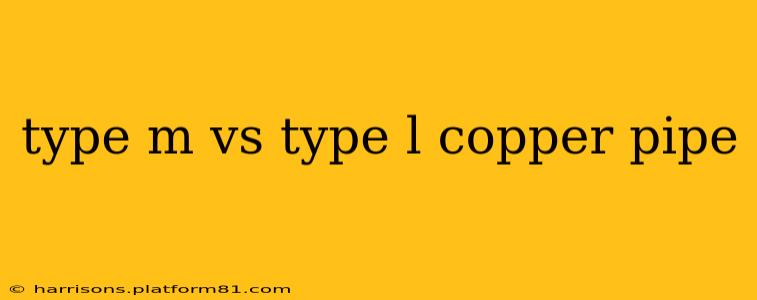Choosing the right copper pipe for your plumbing project is crucial for ensuring longevity, safety, and efficiency. Two common types, Type M and Type L, often leave homeowners and contractors questioning the differences. This detailed comparison will clarify the key distinctions between Type M and Type L copper pipes, helping you make an informed decision.
What are Type M and Type L Copper Pipes?
Both Type M and Type L copper pipes are made from annealed (soft) copper, making them malleable and easy to work with. However, their primary difference lies in their wall thickness. Type L copper pipe has a thicker wall than Type M. This difference directly impacts their pressure ratings, applications, and cost.
Type L Copper Pipe: Strength and Durability
Type L copper pipe boasts a significantly thicker wall, making it the stronger and more durable option. This translates to a higher working pressure rating, making it suitable for high-pressure applications such as:
- Main water lines: Its robustness handles the consistent pressure of the main water supply effectively.
- Underground plumbing: The added protection against external forces like soil pressure and potential damage from ground movement makes it ideal for buried lines.
- High-rise buildings: In taller structures, the increased pressure demands the superior strength of Type L.
Type M Copper Pipe: Cost-Effective Solution
Type M copper pipe, with its thinner wall, is a more economical choice. While still durable, its lower pressure rating makes it best suited for applications with less demanding pressure requirements such as:
- Branch lines: Distributing water within a building often doesn't require the high-pressure capacity of Type L.
- Residential plumbing: In many residential settings, Type M provides sufficient strength for standard plumbing installations.
- Low-pressure systems: It's suitable where pressure fluctuations are less significant.
What is the Pressure Rating Difference?
The key difference between Type M and Type L lies in their pressure ratings. Type L copper pipe generally has a higher pressure rating than Type M. Precise figures vary depending on pipe diameter and local codes, but the thicker walls of Type L allow it to withstand significantly greater water pressure.
What about Type K Copper Pipe?
While we're comparing Type M and Type L, it's worth mentioning Type K. Type K has the thickest wall of the three and is typically used for high-pressure applications demanding extreme durability. However, its thicker walls make it more expensive and more difficult to work with.
Which Type of Copper Pipe Should I Choose?
The best choice depends entirely on your specific needs. Consider these factors:
- Pressure requirements: High-pressure applications necessitate Type L or even Type K.
- Budget: Type M offers a cost-effective solution for lower-pressure systems.
- Local codes: Always check your local building codes for specific requirements regarding pipe types and pressure ratings.
- Installation expertise: Working with thicker-walled pipe requires more experience and specialized tools.
Is Type M Copper Pipe Suitable for Underground Use?
While generally not recommended, Type M might be acceptable for underground installations in specific situations with low water pressure and minimal risk of external damage. However, Type L is always the safer and more reliable option for underground plumbing.
Can I Use Type L Copper Pipe for All My Plumbing Needs?
While Type L is a robust and versatile option, it's not always necessary. Using Type L everywhere might be an unnecessary expense in lower-pressure systems. Choosing the appropriate pipe type based on your project's demands is key to both cost-effectiveness and system integrity.
This comparison provides a comprehensive overview of the differences between Type M and Type L copper pipes. Remember to consult with a qualified plumber or your local building codes to ensure you select the correct pipe type for your specific plumbing project.
